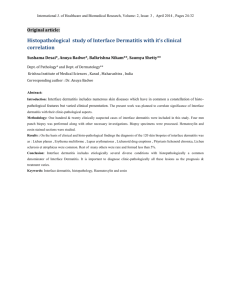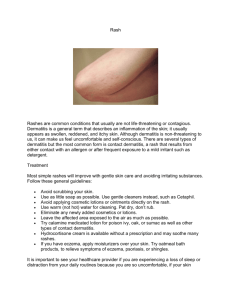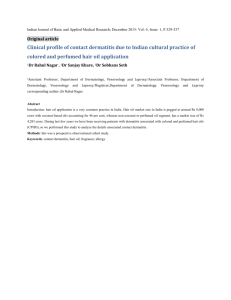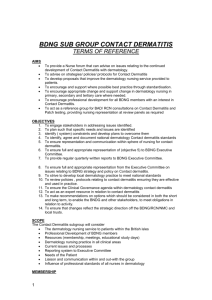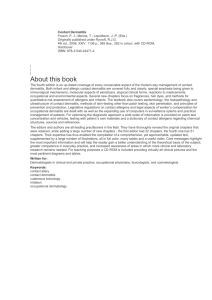Egyptian Dermatology Online Journal Vol. 5 No 2:15, December
advertisement
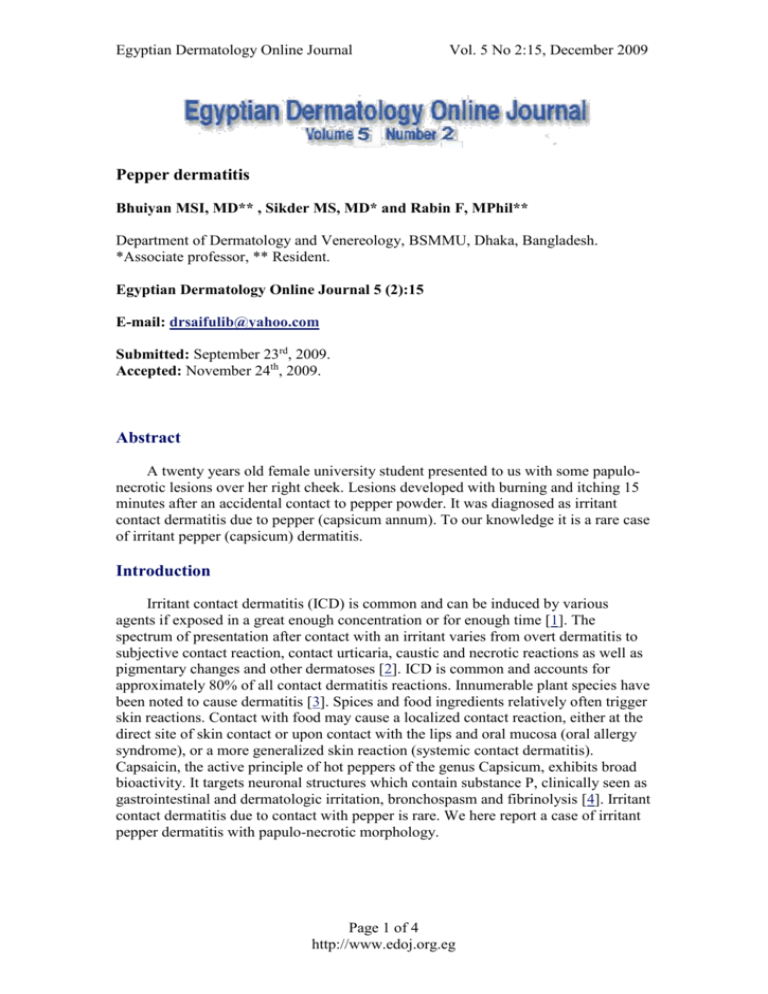
Egyptian Dermatology Online Journal Vol. 5 No 2:15, December 2009 Pepper dermatitis Bhuiyan MSI, MD** , Sikder MS, MD* and Rabin F, MPhil** Department of Dermatology and Venereology, BSMMU, Dhaka, Bangladesh. *Associate professor, ** Resident. Egyptian Dermatology Online Journal 5 (2):15 E-mail: drsaifulib@yahoo.com Submitted: September 23rd, 2009. Accepted: November 24th, 2009. Abstract A twenty years old female university student presented to us with some papulonecrotic lesions over her right cheek. Lesions developed with burning and itching 15 minutes after an accidental contact to pepper powder. It was diagnosed as irritant contact dermatitis due to pepper (capsicum annum). To our knowledge it is a rare case of irritant pepper (capsicum) dermatitis. Introduction Irritant contact dermatitis (ICD) is common and can be induced by various agents if exposed in a great enough concentration or for enough time [1]. The spectrum of presentation after contact with an irritant varies from overt dermatitis to subjective contact reaction, contact urticaria, caustic and necrotic reactions as well as pigmentary changes and other dermatoses [2]. ICD is common and accounts for approximately 80% of all contact dermatitis reactions. Innumerable plant species have been noted to cause dermatitis [3]. Spices and food ingredients relatively often trigger skin reactions. Contact with food may cause a localized contact reaction, either at the direct site of skin contact or upon contact with the lips and oral mucosa (oral allergy syndrome), or a more generalized skin reaction (systemic contact dermatitis). Capsaicin, the active principle of hot peppers of the genus Capsicum, exhibits broad bioactivity. It targets neuronal structures which contain substance P, clinically seen as gastrointestinal and dermatologic irritation, bronchospasm and fibrinolysis [4]. Irritant contact dermatitis due to contact with pepper is rare. We here report a case of irritant pepper dermatitis with papulo-necrotic morphology. Page 1 of 4 http://www.edoj.org.eg Egyptian Dermatology Online Journal Vol. 5 No 2:15, December 2009 Case report A 20 years old unmarried female, who is a university student reported to dermatology out patient department (OPD) of BSM medical university (BSMMU) hospital, with itching, burning and papulo-necrotic skin lesions. The patient was alright two days back when she got an accidental contact with some pepper powder over right side of the face. Just after the contact she had a good wash of the part with profuse cool water. Despite the wash she experienced itching and burning of the part. After about 15 minutes multiple erythematous papules developed over right cheek. Over next two days lesions become necrosed and excoriated by the patient. She did not complained of fever, pain or blistering. On examination there were multiple erythematous, excoriated, papulo-necrotic lesions of about 1-2 mm size present over right side of the face. Lesions were grouped in arrangement and no vesiculation or oozing was noticed. Opposite side of the face was normal. Regional lymph-nodes were non-tender and not enlarged in size. Patient gave personal and family history of atopy. She did not give previous history of such eruption and she did not use any sorts of cosmetics on face on that day or previous few days. The complete blood count with differential analysis, Hb% and erythrocyte sedimentation rate (ESR) were normal. Tests for serum-specific IgE-E antibodies to pepper and patch tests were negative. We diagnosed the case as irritant pepper (capsicum) dermatitis. She was treated with topical 0.1% hydrocortisone cream applied twice over the lesions and response was noticed by the 3rd day and it was completed after 10 days. Fig 1: Irritant pepper dermatitis. Discussion: Capsaicin (8-methyl-N-vanillyl-6-nonenamide) and four of its naturally occurring derivatives contribute to the pungent taste of peppers [5]. The effect of this chemical is so strong, that even when diluted to one part in 11 million of water, a pungent taste remains. These fat-soluble phenols comprise 0.02% of the fresh fruit's weight and 0.5Page 2 of 4 http://www.edoj.org.eg Egyptian Dermatology Online Journal Vol. 5 No 2:15, December 2009 1.0% of the dried fruit's weight [4]. Virtually all forms of chili peppers are members of the species Capsicum annuum (Solanaceae). Cayenne pepper and capsaicin are classified as agents producing immediate non-immunological contact reaction [6]. When applied to the skin, capsaicin depolarizes nerves leading to vasodilatation, smooth muscle stimulation, glandular secretions, and sensory nerve activation. Because the nerves, and not the skin itself, are affected, dose-related cutaneous burning pain, irritation, and erythema, but not blistering ensue [7]. The pain has been described as a dull ache, like sunburn, or like an intense, radiating heat, throbbing and prickling [5]. These symptoms are often delayed and may last hours to days [5]. This problem, known by some as 'Hunan Hand Syndrome' especially occurs among those who prepare their own peppers for eating by roasting them and removing skins from large batches of peppers while they are still warm [8]. An erythematous or bullous dermatitis presumably irritant, has been reported on workers handling wet chill beans, even when they wearing rubber gloves [9]. However no contact dermatitis is commonly seen among housewives [6]. In India Behl and Captain reported 104 cases of sub mucous fibrosis in palate due to high intake of chili, there was recurrent vesicle formation in 13% of the patients [9]. Capsicum sensitivity is newly reported as a cross-reacting food, 2 cases are reported of pepper sensitization in latex-allergic patients [10, 11]. Coopers reported a transient, erythematous dermatitis that formed in 2 infants shortly after breast-feeding from their mothers who had ingested food flavored with red pepper, although the mothers did not display any signs of dermatitis [12]. We are not aware of any reported case of immediate papulo-necrotic reaction to short contact of pepper. So we intend to report this irritant pepper dermatitis with rare papulo-necrotic morphology References 1. Adams RM: Occupational skin disease. 3rd, Grune & Stratton, New York, 1983. 2. Amado A, Taylor JS, Sood A. Irritant contact dermatitis. In: Fitzpatrick's dermatology in general medicine. 7th ed. Sanfransisco, USA: McGraw-Hill publisher; 2007; chapter 46, page: 395-401. 3. Ricks MR, Vogel PS, Elston DM, Hivnor C. Purpuric agave dermatitis, Journal of the American Academy of Dermatology, Volume 40, Number 2, Part 2. 4. Tominack RL, Spyker DA. Capsicum and capsaicin-a review: case report of the use of hot peppers in child abuse. Clin Toxicol 1987; 25(7): 591- 601. 5. Jones LA, Tandberg D, Troutman WG. Household treatment for "Chile burns" of the hands. Clin Toxicol 1987; 25: 483- 491. 6. Cleenewerck MB, Martin P. In. Irritant Dermatitis. By Ai-Lean Chew, Howard I. Maibach, Published in 2006, Springer Publishing Company, page-297. 7. Burnett JW. Capsicum pepper dermatitis. Cutis 1989; 534. 8. Williams SR, Clark RF, Dunford JV. Contact dermatitis associated with capsaicin: Hunan hand syndrome. Ann Emerg Med 1995; 25: 713- 715. Page 3 of 4 http://www.edoj.org.eg Egyptian Dermatology Online Journal Vol. 5 No 2:15, December 2009 9. Behl PN, Captain RM, Bedi BMS, Gupta S. Skin -irritant and sensitizing plants found in India.Behl PN, Irwin hospital, New Delhi, 1966; page-27. 10. Gallo R, Cozzani E, Guarrera M. Sensitization to pepper (Capsicum annum) in a latex-allergic patient. Contact Dermatitis 1997; 37: 36. 11. Voltolini S, Milane P, troise C, Negrini A C. Pepper sensitization in latex allergic patients. Allergologie 1995: 9: 414. 12. Cooper RL, Cooper MM. Red pepper-induced dermatitis in breast-fed infants. Dermatology 1996; 193(1): 61- 62. © 2009 Egyptian Dermatology Online Journal Page 4 of 4 http://www.edoj.org.eg
